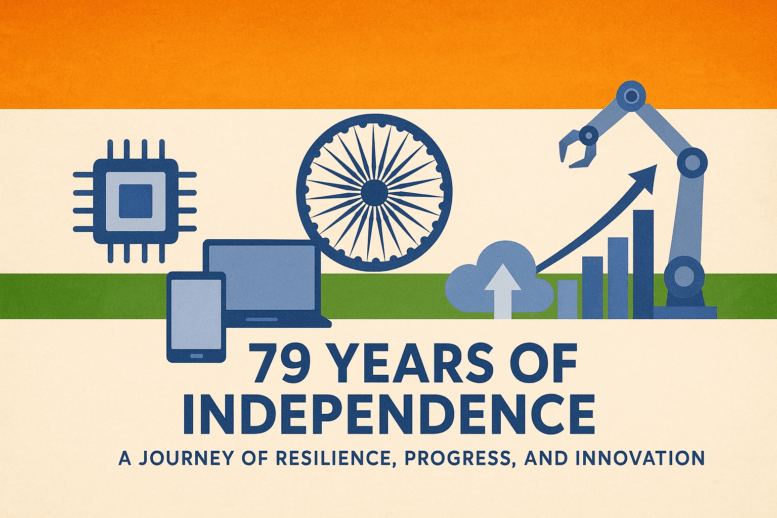
Independence of 1947 — A nation left in shackles
“At the stroke of the midnight hour, when the world sleeps, India will awake to life and freedom.” These immortal words from Jawaharlal Nehru resonate deeply every Independence Day—but what if we add: India awoke to innovation, too.
In August 1947, India emerged with a broken industrial base. Over 70% of people depended on farming. Literacy hovered near 12 percent. Life expectancy stood at about 32 years. The new republic inherited scant factories and little scientific infrastructure. Yet citizens held resolve and hope. Those early constraints set priorities: food, health, schools, and locally-built capacity.
1950s–1960s — Sowing seeds of science and food security
India built technical institutes fast, including IIT Kharagpur in 1951. These colleges trained engineers for nation-building. Agricultural research brought high-yield seeds and irrigation. By the late 1960s, India moved from food imports toward self-sufficiency. These changes raised rural incomes and steadied cities. The groundwork for future industry formed in classrooms and labs.
1970s — Space, nuclear resolve, and scaling supply chains
India formalised its space programme with ISRO in 1969. India launched its first satellite, Aryabhata, in 1975. In 1974, India tested its first nuclear device, signalling strategic independence. Simultaneously, Operation Flood built dairy co-operatives and cold chains, transforming rural incomes. The decade showed the world India’s will to choose technological sovereignty.
1980s — The digital dawn and mass outreach
Computers entered universities and government labs. Satellite programmes and experiments like SITE expanded education into villages. Telecom upgrades began linking cities and small towns. The decade seeded an information economy that would bloom later. In short, India learned how to bring tech to millions affordably and at scale.
1990s — Liberalisation and the software export story
Economic reforms of 1991 opened India’s markets. The IT industry scaled rapidly. Homegrown firms became global service providers. By the mid-1990s, the public internet and mobile telephony arrived. Exports rose steadily, and Indian talent began powering global tech services. This period placed India firmly on the global software map.
2000s — Digital foundations and public goods
Cities modernised with metros and roads. The government invested in e-governance and identity systems. Aadhaar emerged as a national biometric ID project that enrolled over a billion residents. These digital public goods started to lower friction across services. Together, they made inclusion practical, measurable, and scalable. UIDAI
2010s — Payments, startups, and space milestones
The decade saw UPI transform payments into instant, low-cost rails. Fintech startups and unicorns multiplied. In 2014, India reached Mars with the Mars Orbiter Mission, done on a tight budget and global notice. These achievements showcased India’s frugal engineering and digital-first inclusion. WikipediaNational Payments Corporation of India
2020–2025 — Population-scale platforms and green ambition
During the pandemic, India ran large digital vaccination drives and tele-health rollouts. In August 2023, Chandrayaan-3 achieved a soft lunar landing near the Moon’s south pole. This success confirmed India’s autonomous landing capabilities and global leadership in cost-effective missions. Meanwhile, renewable capacity crossed about 220 GW by March 31, 2025. The nation also saw its tech industry revenue cross the $250 billion threshold. Together, these outcomes underscored India’s growth across space, clean energy, and technology. ISROTIMEPress Information Bureaunasscom
Innovations that told the world: sector highlights
IT & software: Services exports and talent made India the world’s digital back office. Recent industry figures show technology revenues exceeding $250 billion.
Digital public goods: Aadhaar and UPI together form a unique inclusion model. They enabled DBT, eKYC, and low-cost payments for millions.
Space: From Aryabhata to Chandrayaan-3, India offered one of the world’s most cost-efficient missions. The Mars Orbiter Mission cost about ₹450 crore.
Biotech & pharma: India produces vaccines at scale and exports low-cost generics worldwide. Its biotech ecosystem expanded rapidly through the 2010s.
Energy & green tech: Solar and wind additions now form a large part of India’s power mix. Renewables reached roughly 220 GW in 2025.
Fintech & inclusion: The JAM trinity—Jan Dhan, Aadhaar, and Mobile—created a template for financial inclusion globally.
Agritech & manufacturing: Precision drones, cold chains, and indigenous manufacturing show how India blends tradition with tech.
The global message
India transformed scarcity into capacity through institutions and innovation. The nation proved that inclusion and scale can become leadership. From “saare jahan se achaa, hindustan humara” to Chandrayaan-3, India showed the world what it can achieve. These achievements reflect collective resolve and national purpose.
